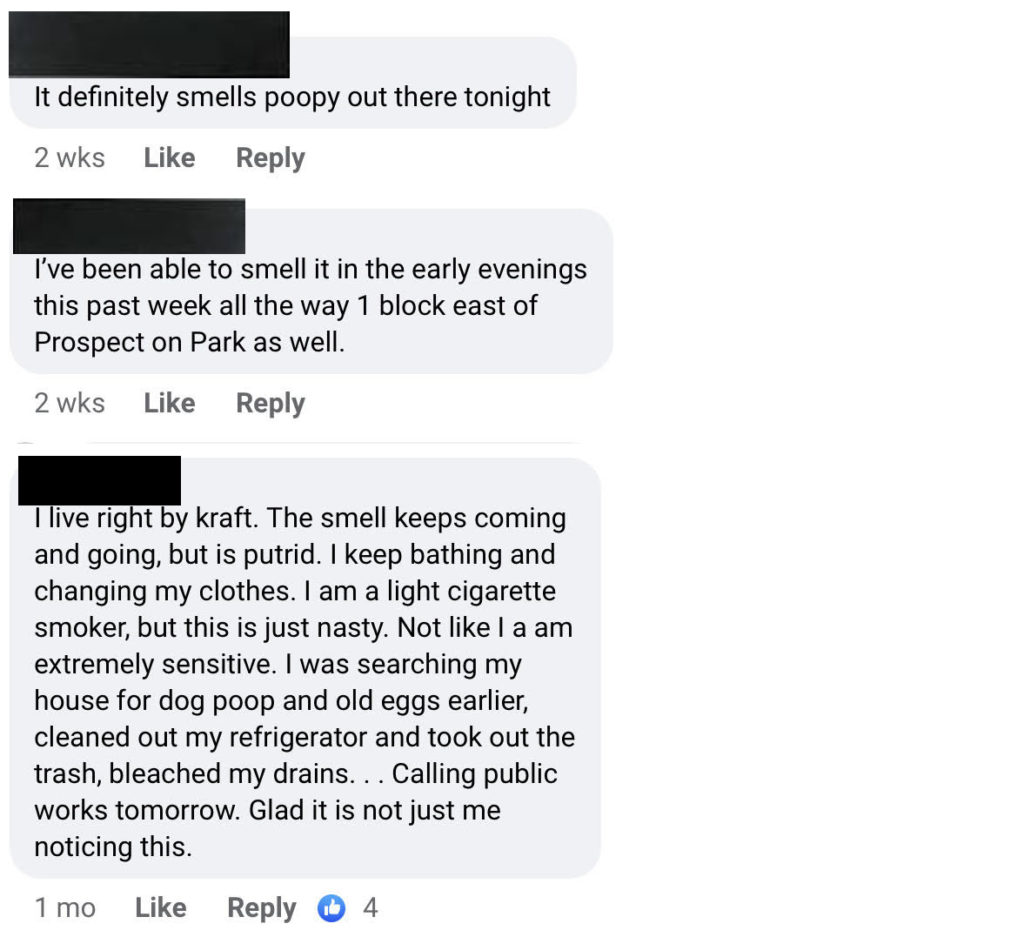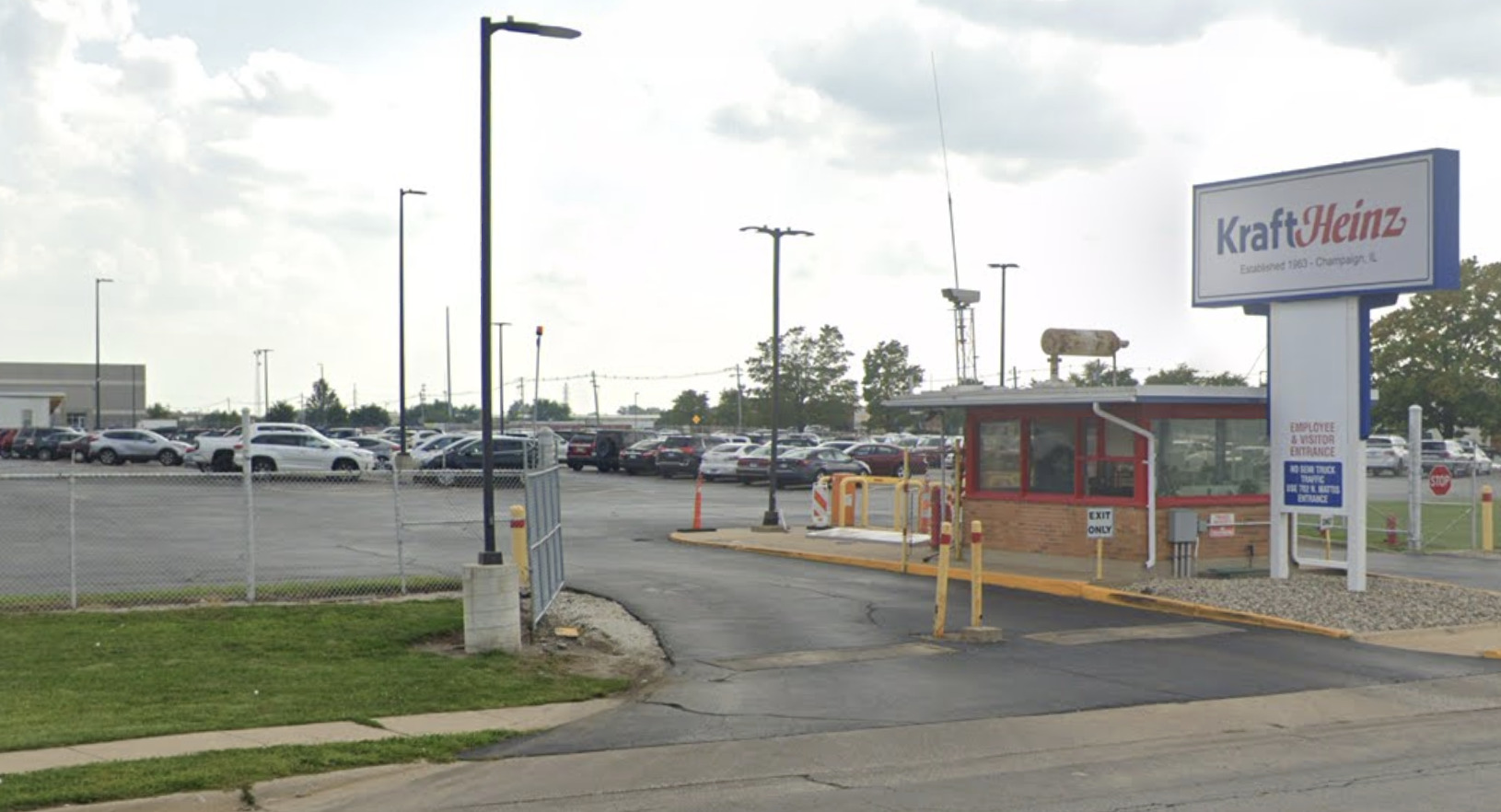Have you noticed a foul and offensive odor permeating throughout Champaign this August? The pungent scent, akin to a dumpster-like stench, has been a persistent presence, causing discomfort and distress to residents. Driving down Prospect or University Avenues, you might have found yourself wrinkling your nose at the unpleasant aroma. It may come and go with the changing direction of the wind. Maybe it’s lingered around your home for days and prevented you from going outside or opening your windows to enjoy the nice weather. For some, this odor situation has escalated beyond a mere annoyance; it has become a headache-inducing and even health-compromising ordeal. In recent developments that might have escaped your notice, the Kraft plant on Bradley Avenue in Champaign has been responsible for emitting egregiously repugnant odors from their on-site sewage pretreatment facility, sparking a frustrating bureaucratic quandary. Regrettably, some of our fellow residents are grappling with this reality as they cope with the overpowering stench that has engulfed Champaign.
What’s particularly concerning is the lackluster response from both government officials and Kraft itself, which has left many feeling unheard and frustrated. While it’s true that Kraft’s operations have emitted distinct odors in the past, the recent olfactory assault is on an entirely different level. Descriptions of the smell range from rotten eggs to decaying waste, with reports indicating that the stench has reached areas far beyond its usual vicinity, reaching as far as Downtown Champaign and Westview Elementary, over a mile away from the plant.
This drastic shift in odor intensity occurred suddenly in early August due to an equipment malfunction at the Kraft plant. The timeline of events reveals a series of shifts in responsibility from the local to county to state to federal, while residents receive no timeline for a resolution to the odor problem:
August 3rd: The Kraft plant’s equipment malfunction triggers the offensive odors, sparking immediate complaints from residents and prompting city officials to investigate.
August 3-8: The city explores its own sewer system as a potential cause before learning about the equipment failure at Kraft when they reach out to Urbana-Champaign Sanitary District (UCSD). UCSD is alerted about elevated ammonia levels in their sewage discharge due to the Kraft malfunction as they have regulatory authority over this system.
Ongoing: The unpleasant smell persists, and complaints continue to pour in from the community.

August 16th: An article published by the News-Gazette sheds light on the situation, providing insight into the events following August 3rd. For most readers, this is the first time learning the source of the odors that had been plaguing them, 13 days after the odors began. UCSD’s Rick Manner clarifies that UCSD is responsible for regulating the sewage equipment and discharges from Kraft, but not the odor or air quality, and directed people to send their odor complaints to the Illinois Environmental Protection Agency (IEPA). Champaign residents begin immediately sending complaints to the IEPA.
August 18th: A follow-up article features statements from a Kraft spokesperson and UCSD’s Manner, assuring the public of safety despite the discomfort. Kraft’s spokesperson is quoted saying that their malfunction resulted in “a small number of people experiencing an unpleasant odor.” Manner is quoted saying that if Kraft was emitting ammonia directly into the air, it would be a “very serious situation requiring an emergency response,” which perhaps unintentionally revealed that they do not consider the present situation to be a very serious situation requiring an emergency response. Notably, while the malfunctioned equipment and elevated ammonia levels have been rectified for some time, Kraft claims they are still collaborating with UCSD to address the lingering smell. This stance appears to contradict Manner’s earlier statement, where he indicated that UCSD wasn’t responsible for odor regulation. It remains unclear whether these measures are prompted by government intervention to regulate the odor as a nuisance to the public, or if Kraft is voluntarily taking these steps.
August 18th: IEPA Representative Brad Frost responds to residents’ complaints, explaining that the agency lacks authority regulating Kraft’s malfunctioned system, and directing complaints to the US Environmental Protection Agency (USEPA). Several residents post the response on Facebook. Brad Frost’s response said:
There was a malfunction in the wastewater pretreatment system [at Kraft] on August 3 that continues to cause odor, which is the subject of your complaint. Illinois law does not give the Illinois EPA authority to regulate the pretreatment system; that is regulatory authority invested (sic) in the United States Environmental Protection Agency [USEPA]
August 24th: A subsequent article by the News-Gazette sheds new light on the situation. According to this article, USEPA became aware of the issue on August 16th and refrains from commenting due to an ongoing enforcement investigation. Kraft outlines a series of actions they’re implementing to eliminate the foul odor.
The timeline illustrates a frustrating cycle of responsibility-shifting and regulatory limitations, leaving residents with no clear resolution in sight. As of August 24th, USEPA has stated they have initiated an ongoing enforcement investigation into the matter, and Kraft has taken some steps to address the odor issue, though the timeline for their resolution remains uncertain. It also remains uncertain if any government bodies are seeking to regulate the odors coming from Kraft as a nuisance to the public, or if they are only focusing on the sewage equipment and sewage discharge.
Odor regulation is a tricky subject. Foul odors may cause nausea, vomiting, headaches, irritation of the eyes, nose and throat, and otherwise be very disruptive to outdoor activities and cause diminishing quality of life, but they are not likely to pose severe health risks. While the damages may not include severe health risks, the people still can seek protection from these odors through nuisance regulation. In the 1970s the EPA decided to leave odors up to states and local governments to regulate as nuisances. Illinois is one of 12 states that has a state law regulating nuisance odors.
In his August 18th email, IEPA’S Frost stated that Illinois law does not give them authority to regulate Kraft’s wastewater pre-treatment system that is causing the odor and referred complaints to USEPA. This statement is confusing because Illinois does have a law to regulate nuisance odors, and because UCSD was already handling the regulatory response to the equipment failure. While residents continue to share complaints further up the chain of command, no regulatory body has said they will hold Kraft responsible for violating nuisance odor regulations, and the odor remains a major problem for those subject to the stench.
In conclusion, the recent onslaught of repugnant odors from the Kraft plant in Champaign has highlighted the need for clearer lines of responsibility and action when it comes to addressing such concerns. Residents have faced an uphill battle in seeking relief, with bureaucracy and regulatory complexities adding to their frustration. As a community, it’s imperative that we hold both corporations and governmental agencies accountable for swiftly addressing issues that impact our quality of life. The ongoing investigation by USEPA presents an opportunity for transparency and resolution, and it is our hope that the concerns of the affected residents will be treated with the seriousness they deserve. Champaign’s well-being hinges on a collaborative effort that prioritizes the health and comfort of its residents.








